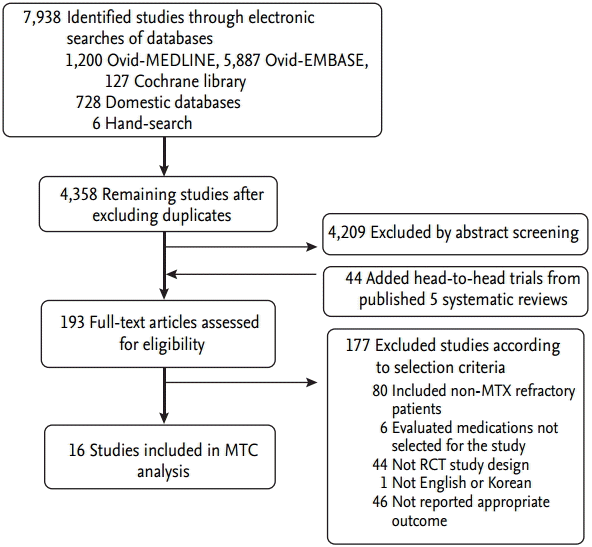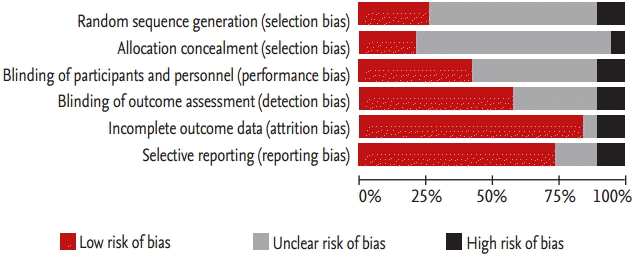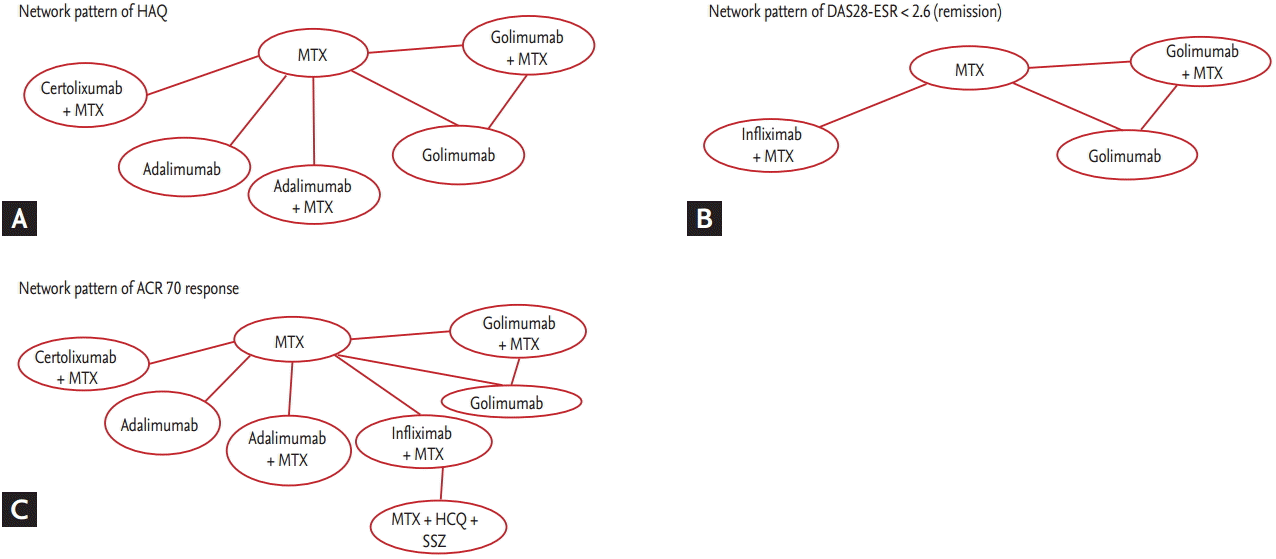1. Schmitz S, Adams R, Walsh CD, Barry M, FitzGerald O. A mixed treatment comparison of the efficacy of anti-TNF agents in rheumatoid arthritis for methotrexate non-responders demonstrates differences between treatments: a Bayesian approach. Ann Rheum Dis 2012;71:225ŌĆō230.


2. Devine EB, Alfonso-Cristancho R, Sullivan SD. Effectiveness of biologic therapies for rheumatoid arthritis: an indirect comparisons approach. Pharmacotherapy 2011;31:39ŌĆō51.


3. Gallego-Galisteo M, Villa-Rubio A, Alegre-del Rey E, Marquez-Fernandez E, Ramos-Baez JJ. Indirect comparison of biological treatments in refractory rheumatoid arthritis. J Clin Pharm Ther 2012;37:301ŌĆō307.


4. Singh JA, Cameron DR. Summary of AHRQŌĆÖs comparative effectiveness review of drug therapy for rheumatoid arthritis (RA) in adults: an update. J Manag Care Pharm 2012;18(4 Supp C):S1ŌĆōS18.

5. Golicki D, Newada M, Lis J, Pol K, Hermanowski T, Tlustochowicz M. Leflunomide in monotherapy of rheumatoid arthritis: meta-analysis of randomized trials. Pol Arch Med Wewn 2012;122:22ŌĆō32.


6. Ahn J, Choi S, Cho S, Tchoe HJ. Bayesian Meta-Analysis Method. Seoul: National Evidence-based Healthcare Collaborating Agency, 2014.
7. Higgins JP, Green S. Cochrane Handbook for Systematic Reviews of Interventions. Chichester: Wiley-Blackwell, 2008.
8. Whitlock EP, Lin JS, Chou R, Shekelle P, Robinson KA. Using existing systematic reviews in complex systematic reviews. Ann Intern Med 2008;148:776ŌĆō782.


10. Gaujoux-Viala C, Smolen JS, Landewe R, et al. Current evidence for the management of rheumatoid arthritis with synthetic disease-modifying antirheumatic drugs: a systematic literature review informing the EULAR recommendations for the management of rheumatoid arthritis. Ann Rheum Dis 2010;69:1004ŌĆō1009.


11. Turkstra E, Ng SK, Scuffham PA. A mixed treatment comparison of the short-term efficacy of biologic disease modifying anti-rheumatic drugs in established rheumatoid arthritis. Curr Med Res Opin 2011;27:1885ŌĆō1897.


12. Graudal N, Jurgens G. Similar effects of disease-modifying antirheumatic drugs, glucocorticoids, and biologic agents on radiographic progression in rheumatoid arthritis: meta-analysis of 70 randomized placebo-controlled or drug-controlled studies, including 112 comparisons. Arthritis Rheum 2010;62:2852ŌĆō2863.


13. Genovese MC, Han C, Keystone EC, et al. Effect of golimumab on patient-reported outcomes in rheumatoid arthritis: results from the GO-FORWARD study. J Rheumatol 2012;39:1185ŌĆō1191.


14. Huang J, Xie B, Li Q, et al. Infliximab reduces CD147, MMP-3, and MMP-9 expression in peripheral blood monocytes in patients with active rheumatoid arthritis. Eur J Pharmacol 2013;698:429ŌĆō434.


16. Joo K, Park W, Kwon SR, Lim MJ. Safety and efficacy evaluation for the addition of either etanercept or leflunomide in Korean rheumatoid arthritis patients inadequately responding to methotrexate. J Rheum Dis 2013;20:166ŌĆō171.

17. Kameda H, Ueki Y, Saito K, et al. Etanercept (ETN) with methotrexate (MTX) is better than ETN monotherapy in patients with active rheumatoid arthritis despite MTX therapy: a randomized trial. Mod Rheumatol 2010;20:531ŌĆō538.


18. Kay J, Matteson EL, Dasgupta B, et al. Golimumab in patients with active rheumatoid arthritis despite treatment with methotrexate: a randomized, double-blind, placebo-controlled, dose-ranging study. Arthritis Rheum 2008;58:964ŌĆō975.


19. Keystone E, Van Der Heijde D, Mason D Jr, et al. Certolizumab pegol plus methotrexate is significantly more effective than placebo plus methotrexate in active rheumatoid arthritis: findings of a fifty-two-week, phase III, multicenter, randomized, double-blind, placebo-controlled, parallel-group study. Arthritis Rheum 2008;58:3319ŌĆō3329.


21. Keystone EC, Schiff MH, Kremer JM, et al. Once-weekly administration of 50 mg etanercept in patients with active rheumatoid arthritis: results of a multicenter, randomized, double-blind, placebo-controlled trial. Arthritis Rheum 2004;50:353ŌĆō363.


25. van Vollenhoven RF, Ernestam S, Geborek P, et al. Addition of infliximab compared with addition of sulfasalazine and hydroxychloroquine to methotrexate in patients with early rheumatoid arthritis (Swefot trial): 1-year results of a randomised trial. Lancet 2009;374:459ŌĆō466.


26. Weinblatt ME, Bingham CO 3rd, Mendelsohn AM, et al. Intravenous golimumab is effective in patients with active rheumatoid arthritis despite methotrexate therapy with responses as early as week 2: results of the phase 3, randomised, multicentre, double-blind, placebo-controlled GO-FURTHER trial. Ann Rheum Dis 2013;72:381ŌĆō389.


27. Weinblatt ME, Keystone EC, Furst DE, et al. Adalimumab, a fully human anti-tumor necrosis factor alpha monoclonal antibody, for the treatment of rheumatoid arthritis in patients taking concomitant methotrexate: the ARMADA trial. Arthritis Rheum 2003;48:35ŌĆō45.


29. Canadian Agency for Drugs and Technologies in Health. Therapeutic review. Clinical and economic overview: biological response modifier agents for adults with rheumatoid arthritis [Internet]. Ottawa (ON): Canadian Agency for Drugs and Technologies in Health, c2010. [cited 2016 Apr 22]. Available from:
https://www.cadth.ca/media/pdf/TR_RA_Clinical_and_Economic_Overview_e.pdf.
33. Launois R, Avouac B, Berenbaum F, et al. Comparison of certolizumab pegol with other anticytokine agents for treatment of rheumatoid arthritis: a multiple-treatment Bayesian metaanalysis. J Rheumatol 2011;38:835ŌĆō845.


34. Nesbitt A, Fossati G, Bergin M, et al. Mechanism of action of certolizumab pegol (CDP870): in vitro comparison with other anti-tumor necrosis factor alpha agents. Inflamm Bowel Dis 2007;13:1323ŌĆō1332.


35. Nesbitt A, Fossati G, Brown D, Henry A, Palframan R, Stephens S. Effect of structure of conventional anti-TNFs and certolizumab pegol on mode of action in rheumatoid arthritis. Ann Rheum Dis 2007;66(Suppl 2):296.
36. Goekoop-Ruiterman YP, de Vries-Bouwstra JK, Allaart CF, et al. Clinical and radiographic outcomes of four different treatment strategies in patients with early rheumatoid arthritis (the BeSt study): a randomized, controlled trial. Arthritis Rheum 2005;52:3381ŌĆō3390.


38. Jansen JP, Fleurence R, Devine B, et al. Interpreting indirect treatment comparisons and network meta-analysis for health-care decision making: report of the ISPOR Task Force on Indirect Treatment Comparisons Good Research Practices: part 1. Value Health 2011;14:417ŌĆō428.


39. Ades AE, Madan J, Welton NJ. Indirect and mixed treatment comparisons in arthritis research. Rheumatology (Oxford) 2011;50 Suppl 4:iv5ŌĆōiv9.








 PDF Links
PDF Links PubReader
PubReader ePub Link
ePub Link Full text via DOI
Full text via DOI Download Citation
Download Citation Print
Print





